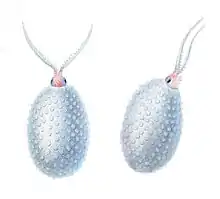Cranchia scabra
Cranchia scabra is a species of glass squid. It is the only species in the genus, and is fairly small (about 150 mm). The mantle is covered by large, multi-pointed cartilagenous tubercles. When disturbed, the squid often pulls its head and arms into the mantle cavity and folds its fins tightly against the mantle to form a turgid ball. The tubercules, presumably, provide some type of protection, but it is unclear what predators are affected and how. In addition, the squid may ink into the mantle cavity, making the ball opaque. This was thought to be an aberrant behavior due to stress and confinement of shipboard aquaria until the same inking behavior was seen in cranchiids from submersibles. The function of this behavior is unknown.[3]
| Cranchia scabra | |
|---|---|
 | |
| Scientific classification | |
| Domain: | Eukaryota |
| Kingdom: | Animalia |
| Phylum: | Mollusca |
| Class: | Cephalopoda |
| Order: | Oegopsida |
| Family: | Cranchiidae |
| Subfamily: | Cranchiinae |
| Genus: | Cranchia Leach, 1817 |
| Species: | C. scabra |
| Binomial name | |
| Cranchia scabra | |
| Synonyms[2] | |
| |
The genus contains bioluminescent species.[4] It is named for John Cranch.[5][6]
References
- Barratt, I.; Allcock, L. (2014). "Cranchia scabra". IUCN Red List of Threatened Species. 2014: e.T162941A955561. doi:10.2305/IUCN.UK.2014-1.RLTS.T162941A955561.en. Retrieved 19 November 2021.
- Julian Finn (2016). "Cranchia scabra Leach, 1817". World Register of Marine Species. Flanders Marine Institute. Retrieved 26 February 2018.
- Richard E. Young; Katharina M. Mangold. "Cranchia scabra Leach 1817". The Tree of Life Web Project. Retrieved 26 February 2018..
- Herring, Peter J. (1987). "Systematic distribution of bioluminescence in living organisms". Journal of Bioluminescence and Chemiluminescence. 1 (3): 147–163. doi:10.1002/bio.1170010303. PMID 3503524.
- David M. Damkaer (2002). "Adding pages". The Copepodologist's Cabinet: A Biographical and Bibliographical History, Volume 1. Memoirs of the American Philosophical Society, Volume 240. American Philosophical Society. pp. 131–155. ISBN 978-0-87169-240-5.
- White, Adam (1857). A Popular History of British Crustacea; Comprising a Familiar Account of Their Classification and Habits. Lovell Reeve. pp. 249–250.
External links
- "CephBase: Cranchia scabra". Archived from the original on 2005-08-17.
- Tree of Life web project: Cranchia scabra
